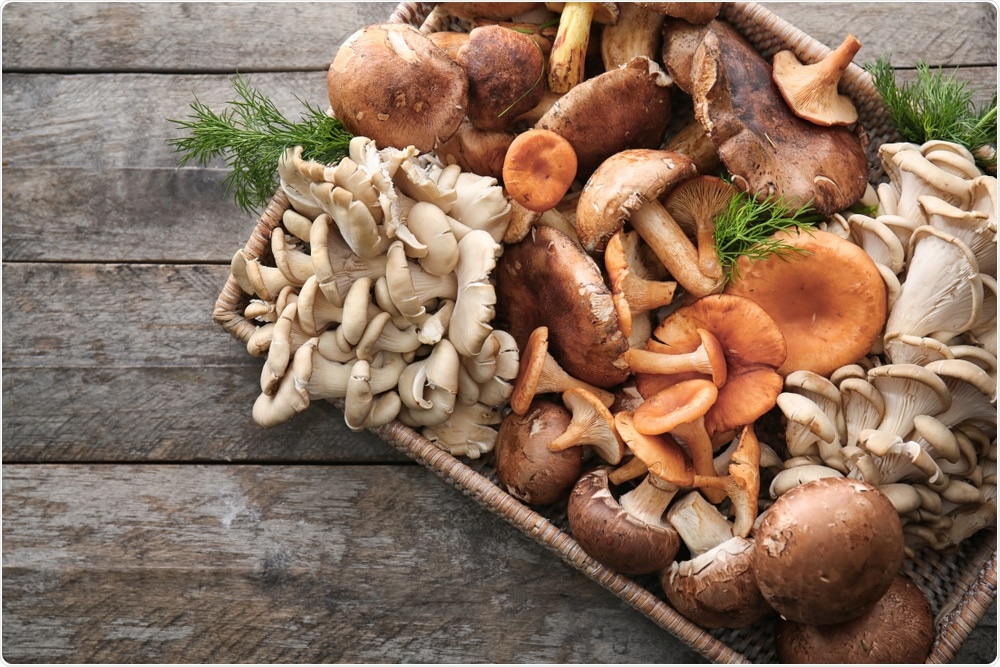Mushrooms are a protein- and mineral-rich food source, but they can also accumulate high levels of toxic metals and metalloids.

Image Credit: Africa Studio/Shutterstock.com
Most studies investigating the concentrations of these elements have focused on fresh mushrooms rather than dried ones. Some research investigating the drying process has shown that drying does not result in any significant loss of nutrients and produces higher concentrations of proteins and carbohydrates, for example.
Researchers suspect that this may also apply to toxic trace elements such as mercury (Hg), cadmium (Cd), lead (Pb) and arsenic (As).
Long-term exposure to these elements has been associated with adverse health effects, including certain types of cancer and regulations are therefore in place to limit the levels of these toxic substances in food items.
Currently, this legislation does not cover as many foods as might be anticipated, given the data available from toxicological studies.
European legislation, for example, only accounts for maximum levels of two toxic trace metals in three mushroom species. However, this legislation applies to fresh mushrooms and does not adjust for changes in levels of these elements that may result from drying.
Furthermore, risk assessments of food consumption generally account for contaminants found in fresh or dried food items and do not consider two important factors that may significantly influence risk, which are the effects of cooking and bioaccessibility (the proportion digested and absorbed in the gut).
Recently, researchers from the Instituto de Agroquímica y Tecnología de Alimentos (IATA-CSIC) in Valencia, Spain have tested the concentrations of Hg, Cd, Pb, and As in eleven species of dried mushroom and examined the effects of cooking and bioaccessibility.
By evaluating these factors, the study covers a gap in knowledge about the food safety of these products and helps to improve the assessment of the risk associated with their consumption,”
For the study, Dinoraz Vélez and colleagues obtained samples of the following mushroom species from various establishments in Spain.
- Amanita caesarea
- Amanita ponderosa
- Boletus edulis
- Cantharellus lutescens
- Cantharellus tubaeformis
- Hydnum repandum
- Lactarius deliciosus
- Lentinula edodes
- Lepiota procera
- Marasmius oreades
- Tricholoma georgii
Two or more samples from each batch were evaluated for each species and divided into raw products that were stored at 4°C and those that were cooked (according to manufacturers’ instructions), drained and stored at −20 °C.
To assess bioaccessibility, an in vitro gastrointestinal digestion model that simulates human digestion was applied.
What does the legislation say?
According to the Chinese regulations on mushrooms, the maximum content of the elements tested for in this study is limited to: 0.1 mg/kg for Hg (1 mg/kg for dried); 0.2 mg/kg for Cd (2 mg/kg for dried); 0.5 mg/kg for As (5 mg/kg for dried) and 1 mg/kg for Pb (10 mg/kg for dried).
What did the study find?
“Some of the samples analyzed in the present study exceeded the Chinese limits for Cd and Hg,” writes the team.
The elements present at high levels in raw dried mushrooms were Hg, at levels ranging from 0.003 to 10.3 mg/kg and Cd, at levels ranging from 0.049–4.53 mg/kg. The species with the highest level of Hg were Amanita ponderosa, which ranged from 7.20–10.3 mg/kg, Tricholoma georgii (3.45 to 4.26 mg/kg) and Boletus edulis (0.95–1.84 mg/kg).
The species with the highest levels of Cd were T. georgii (0.855–2.82 mg/kg), B. edulis (0.756–1.31 mg/kg) and Amanita caesarea (0.85–4.53 mg/kg).
As levels ranged from 0.025 to 1.01 mg/kg and the Pb level from 0.034 and 1.94 mg/kg.
Currently, EU legislation only sets maximum levels for one of the mushroom species tested in this study, which is Shiitake.
“According to the Chinese regulations, there could be a food safety problem with these mushroom species, and therefore the European Union should extend the monitoring and control of contaminants to a greater number of species than those currently contemplated in its regulations,”
To evaluate the effects of cooking on these elements, the team selected the mushrooms with the highest levels of trace elements.
In all cases, the presence of trace elements was reduced following cooking, although the reduction was only significant for As, which was reduced by a median of 52%. In 60% of mushrooms, Cd fell by a median of 48% and Pb by a median of 25%. In 20% of the samples, Hg fell by a median of 31%.
When the team evaluated the bioaccessibility of the toxic elements in the cooked mushrooms, the results suggested that the cooking process had significantly reduced the risk associated with the consumption of Pb, Cd, and Hg.
However, it had increased the bioaccessibility of As, meaning the reduction in risk associated with the intake of this element was substantially lower.
The authors say this in vitro data demonstrate that cooking and gastrointestinal digestion decrease the levels of trace elements that would be expected to reach the systemic circulation if raw mushrooms were consumed.
“Taking the effects of cooking and gastrointestinal digestion into account gives a more realistic estimate of the risk associated with the consumption of mushrooms,” write the researchers
The influence of these factors should be confirmed in vivo, to see whether, although some of these mushrooms have Hg and Cd values above legislated limits, the quantity of these elements that would reach the systemic circulation after processing and digestion would not be such as to represent a risk, from a toxicological point of view,”
Journal reference:
Vélez D, et al. Toxic trace elements in dried mushrooms: Effects of cooking and gastrointestinal digestion on food safety. Food Chemistry. https://doi.org/10.1016/j.foodchem.2019.125478